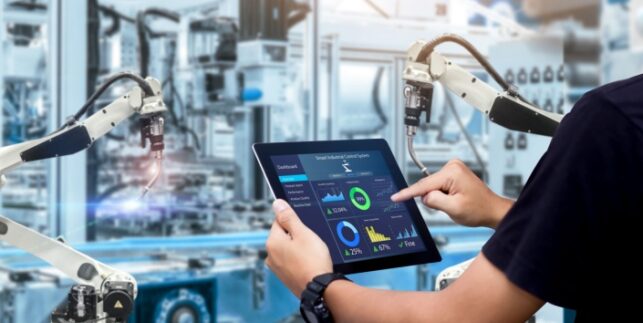National Strategy for Advanced Manufacturing – How Can Manufacturers Be Ready?

The United States has reaffirmed its commitment to advancing the manufacturing sector with the announcement of the National Strategy for Advanced Manufacturing on October 7th, 2022, a date celebrated throughout the industry each year as National Manufacturing Day.
The strategy, its goals, and its recommendations were developed by the Subcommittee on Advanced Manufacturing as a whole-government approach to guide policy and action for the next four years and beyond. The strategy identifies three key goals related to the maintenance and improvement of the US manufacturing industry:
- Developing and implementing advanced manufacturing technologies
- Growing the advanced manufacturing workforce
- Building resilience into essential manufacturing supply chains
These three goals form the foundation of an ongoing effort to revitalize US manufacturing through the development and implementation of new technologies. They’ll serve to guide policy-making, investments, and partnerships for federal programs and agencies with the aim of building a stronger manufacturing sector than ever before.
Over the coming years, manufacturers will see both opportunities and obligations arising from the impact of the strategy, and forward-thinking manufacturers stand to gain a major foothold in the merging landscape of advanced manufacturing. Manufacturers can expect to see changes made at multiple levels to move the country toward the 11 key objectives highlighted in the strategy.
1. Clean and Sustainable Manufacturing
The very first objective of the strategy focuses on sustainable manufacturing and decarbonization. The need to implement sustainable manufacturing processes in the face of climate change is clear, and significant efforts are underway and planned to reduce greenhouse gas emissions. The US and many other nations are committed to reaching net-zero emissions by 2050.
Advanced manufacturing processes will play a significant role in reaching that goal. The strategy is set to support new energy sources, feedstocks, and processes that reduce emissions. There is also a focus on validation tools required to track and monitor emissions, making it possible for manufacturers to better understand their emissions and how to move toward sustainable manufacturing. Similar efforts are underway for new recycling development alongside emissions reduction.
2. Focusing on Microelectronics and Semiconductors
The strategy identifies microelectronics and semiconductors as one of the most important sectors for the US to target over the coming years. These components are found everywhere and are a vital link in the supply chain. Numerous other acts are already taking action in this sector.
The strategy highlights the need for both new advanced manufacturing methods in the sector along with improving throughput and reliability. In such a high-volume sector where quality is paramount, manufacturers need solutions that let them monitor production as effectively as possible.
3. Supporting the Bioeconomy
The bioeconomy is the sector of the economy driven by innovation in biomanufacturing, using conventional or engineered microbes to produce food, fuel, fibers, plastics, chemicals, and other products. The strategy stresses the need to bring these innovative technologies to scale.
Biomass processing and conversion already provide fuel and other resources and will play a larger role in the future. These processes often rely on delicate balances where key parameters must be monitored and controlled with precision beyond that required for conventional manufacturing processes. Advancements such as statistical process control make it possible to anticipate process upsets before they happen, which can greatly improve performance in these delicately balanced processes.
4. New Technologies and Processes
The development of new alloys, synthetic biological materials, plastics, and other materials provides an essential foundation for new applications throughout many industries. The strategy focuses on the research and development of new materials, along with the development of practical methods for processing these new materials.
This objective also includes the reduction or replacement of scarce or hazardous materials. Many manufacturers may see certain raw materials replaced with alternatives in the near future, necessitating change on the shop floor. They’ll need quality control and recipe management capabilities to ensure that they can adapt and continue to thrive in the evolving landscape.
5. The Future of Smart Manufacturing
One of the most significant objectives of the strategy is the development and implementation of Industry 4.0 smart manufacturing technologies and solutions. Interconnectivity, automation, and visibility are already important today and will play an increased role in the future of advanced manufacturing.
Many manufacturers today already have effective Industry 4.0 solutions in place that let them collect and analyze production data and provide the tools necessary to put those insights to work on the shop floor. Technologies such as machine learning, digital twins, and more are making it possible for manufacturers to achieve more than ever before.
The strategy also highlights the need for human-centered technology adoption. Industry 4.0 solutions need to be implemented in a way that makes the most of human resources, with interactions that provide the right information to the appropriate stakeholders when they need it. The true value of Industry 4.0 lies in empowering production teams and management to do their jobs more effectively.
6. Expanding the Advanced Manufacturing Talent Pool
As the United States pushes for expansion in advanced manufacturing, it has recognized the need for a workforce tailored to the unique challenges that roles in the new landscape will offer. The strategy seeks to promote awareness of advanced manufacturing careers, along with engaging underrepresented communities and addressing social barriers.
7. Developing Advanced Manufacturing Education and Training
Advanced manufacturing requires educated and trained stakeholders throughout every level, and the strategy is committed to ensuring that education and training opportunities are available at the scale they’ll be needed. There is a major focus on modernizing career and technical education and offering partnership training programs that provide hands-on experience.
8. Strengthening Connections Between Employers and Education
The strategy identifies the lack of work-based learning and apprenticeships throughout advanced manufacturing as an important barrier to overcome. In order to develop the workforce needed for advanced manufacturing, the strategy seeks to encourage and foster high-quality apprenticeships, along with the standardization of credentials and certifications throughout the industry.
9. Enhancing Supply Chain Connections
Manufacturing supply chains are a significant example of how the US has lagged behind competitors in recent years. As such, the strategy includes measures intended to bolster supply chains, particularly by developing better connections between manufacturers of all sizes throughout the United States.
The digital transformation of supply chains will play a major role in this area. Through the use of digital twins and other Industry 4.0 technologies, manufacturers can develop complete visibility from start to finish for their processes. The strategy also seeks to build trust and transparency between supply chain participants, so this visibility could play a vital role in connectivity with partners and suppliers for manufacturers.
10. Reducing Manufacturing Supply Chain Vulnerabilities
The COVID-19 pandemic and other global events have demonstrated a wide range of supply chain vulnerabilities over the past years. Securing supply chain resilience is a top priority within the strategy, with key areas of focus including traceability, visibility, risk management, and agility.
Developing traceability and visibility throughout the supply chain as a whole requires each manufacturer to achieve those goals internally. Manufacturers need to know what’s happening on their factory floor at any given moment if they are going to be able to communicate capacities and delays to other parties within the supply chain. Those same capabilities play a vital role in agility, allowing manufacturers to react to events as they happen and pivot their operations to adjust to changing demands.
11. Revitalizing Advanced Manufacturing Ecosystems
The strategy recognizes that one of the greatest strengths of the American manufacturing industry is the breadth and variety of sectors it encompasses. The combined ecosystem of suppliers and partners strengthens the industry as a whole, and developing that ecosystem is a significant objective.
To do so, the strategy seeks to foster new business development and growth, improve public-private partnerships, and build and strengthen regional manufacturing networks. With the right support and the solutions they need, manufacturers of any size can move toward the advanced manufacturing principles highlighted by the strategy.
Taking the First Steps Toward Advanced Manufacturing
Many of the objectives outlined in the National Strategy for Advanced Manufacturing and other measures supporting manufacturing are focused on the development of new processes and technologies. However, there are steps that manufacturers can take today to start moving toward advanced manufacturing.
Matics Real-time Operational Intelligence (RtOI) is an Industry 4.0 solution that supports many of the outcomes specified by the National Strategy for Advanced Manufacturing. Manufacturers can develop the visibility and understanding of their shop floors that they need to implement sustainability policies, improve throughput, and achieve higher quality standards.
RtOI already features machine learning, digital twins, statistical process control, and other advanced manufacturing technologies highlighted by the strategy. The solution also includes advanced work management tools that let manufacturers transform insights into action and achieve major improvements and optimizations on the factory floor.
If you want to prepare your organization for the evolving landscape of advanced manufacturing, you can reach out to Matics for a demo today.





